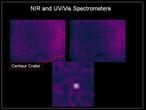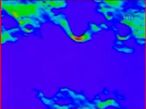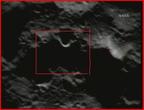Observing to the last second
LCROSS Crashes on the Moon
LCROSS followed close behind and flew through the cloud of material with all its sensors working to perfection. In fact LCROSS crashed only four minutes after Centaur. The astronomers gained important data from which they hope to learn more about the composition of the Moon. Specifically the scientists are looking for water. Already earlier measurements of the Japanese probe Kaguya showed high concentration of hydrogen in the crater, which opens the possibility of the existence of water ice.
The impact of LCROSS itself just created a small crater about four minutes and lots of data gathering later. Many earthbound telescopes of professional and amateur astronomers observed the impacts on the southern "edge" of the Moon. NASA TV broadcast the event live. They expected a cloud up to 4 miles high and casts a shadow all the way to the other side of the crater.
Redshift-live will continue its updates as more information becomes available.
Source: NASA
Observing to the last second
LCROSS Crashes on the Moon
LCROSS followed close behind and flew through the cloud of material with all its sensors working to perfection. In fact LCROSS crashed only four minutes after Centaur. The astronomers gained important data from which they hope to learn more about the composition of the Moon. Specifically the scientists are looking for water. Already earlier measurements of the Japanese probe Kaguya showed high concentration of hydrogen in the crater, which opens the possibility of the existence of water ice.
The impact of LCROSS itself just created a small crater about four minutes and lots of data gathering later. Many earthbound telescopes of professional and amateur astronomers observed the impacts on the southern "edge" of the Moon. NASA TV broadcast the event live. They expected a cloud up to 4 miles high and casts a shadow all the way to the other side of the crater.
Redshift-live will continue its updates as more information becomes available.
Source: NASA









